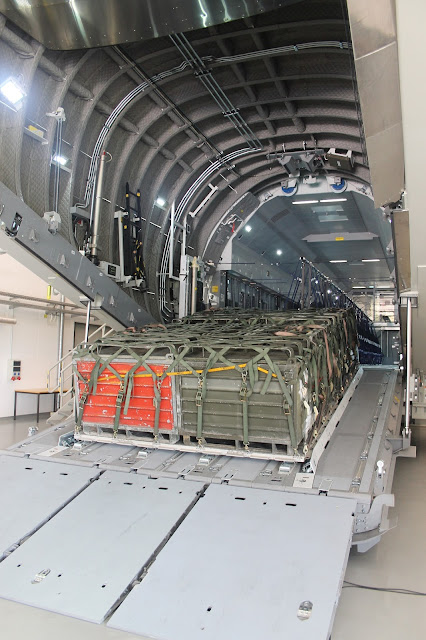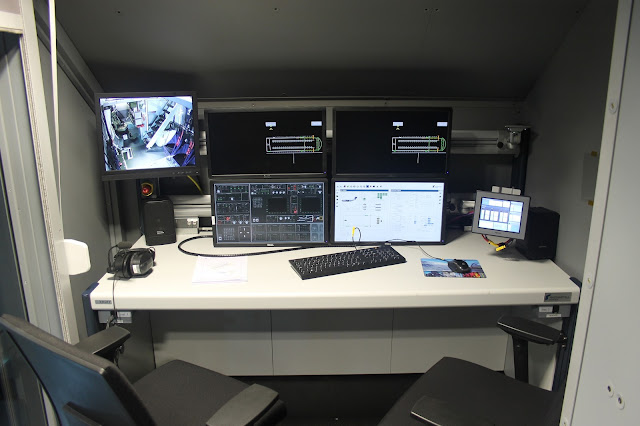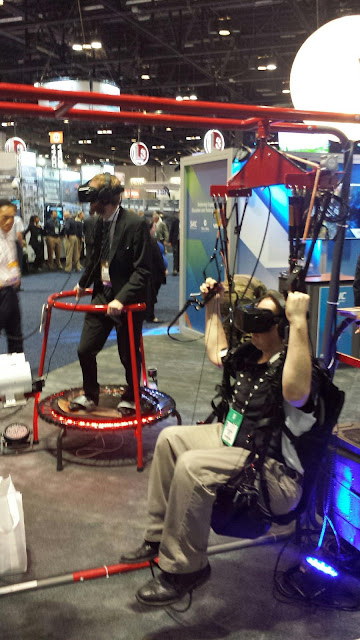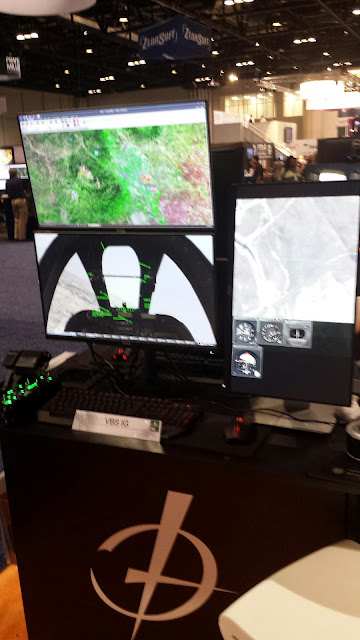“Train as you fight!” has become a popular slogan routinely referred to within the British Armed Forces when conducting training scenarios prior to deployment. In essence, it demands that exercising troops must exert the same energy and intensity in the training environment as employed during live combat operations. However, in reality, such a pre-requisite has proven very difficult to simulate. Here is why.
 |
| The US Army and other Armed Forces around the world continue to rely upon Meggitt's simulation technology which provide not only marksmanship training but also situation awareness and escalation of force training. (Photo: Meggitt Training Systems) |
There remains a school of thought within existing ranks of NATO SOF that live fire training is the most efficient method of training. However, even this specialist community has come to benefit from a variety of low-end to high-end simulation training systems now routinely relied upon to train up during mission specific pre-deployment training as well as wider contingency operations which could be required in the future.
Options available range from blank, paint marking and low-velocity ammunition, through to laser-based, holographic and fully immersive Virtual Reality (VR) systems. Looking further ahead, the introduction of Augmented Reality (AR) technology could see simulation and training escalated to another level entirely.
Counter-Terrorism Training
In the realm of counter-terrorism (CT) training, the world’s most advanced SOF units have utilised “Killing Houses,” featuring reinforced walls and lead curtains to nullify the ballistic properties of 9x19mm and 5.56x45mm when fired at very short ranges. Added to utility of stun and smoke grenades, the loud noises and smell of burning cordite provide the most realistic scenarios in relation to close combat missions. Such practices continue to this day and current thinking within the SOF community remains split as to whether there is a more optimal simulation and training solution available.
 |
| The GDOTS SIMUNITION range of marker rounds have been a stalwart of special operations training regimes around the world, pictured here in 5.56x45mm link. (Photo: General Dynamics Ordnance and Tactical Systems) |
Reduced energy ammunition alternatives include
General Dynamics Ordnance and Tactical Systems’ (GDOTS) Close Quarters Target (CQT) ammunition, available in 5.56x45mm, designed to be fired from duty weapon systems with an easy-to-install “blue-bolt” conversion kit. The bolt conversion prevents the loading and ignition of live ammunition.
Once converted, the weapon system is capable of firing CQT ammunition with recoil similar to duty ammunition along with “tactical accuracy at distances up to 30m)- ideal for CT training which can include room, building and compound clearance operations. The CQT ammunition can also be used in machine guns, a spokesperson for GDOTS explained.
As an alternative, SOF routinely use paint marking rounds such as the GDOTS FX Marking Cartridges, also available in 5.56x45mm calibre. Similar to CQT ammunition, the FX rounds provide a, “
close-range combat training system,” allowing operators and opposing forces (OPFOR) to mark targets without rifle of serious injury.
A GDOTS source explained to MT: “
These cartridges produce near-normal recoil and deliver good tactical accuracy up to 30 metres. Their colour projectiles leave a detergent-based, water-soluble inert colour mark.”
SOF have also relied on 7.62x51mm training rounds including GDOTS’ Short Range Training Short Stop, designed for use on range complexes where the danger of ricochet and stray bullets can pose a problem for training troops.
The Short Stop ammunition has a maximum range of 100m, with the round falling off once the projectile destabilises beyond this range. Made of a frangible bronze and copper filled polymer, the ammunition round also reduces environmental contamination.
On 15 September, the US Army Contracting Command unveiled an RfP to GDOTS Canada for the provision of 9mm M1041 Practice Ammunition Cartridges for use in Close Combat Mission Capability Kits.
The latter includes blue and red marking rounds, fired from converted Beretta M9 9mm handguns, M11 handguns and M4 5.56mm carbines, all of which are fitted with CCMCK barrels. The latter carbine is also fitted with an Upper Receiver Conversion Kit.
Such a concept allows training soldiers to carry primary and secondary weapon systems with an ability to engage enemy targets at 5ft and beyond using low velocity marking ammunition.
Holding Live Weapons like Muscle Memory
According to
Eric Perez, Director of Virtual Sales for Meggitt Training Systems, the main issue in the military simulation market is the fact that requirements of customers and their respective Armed Forces remain incredibly individual.
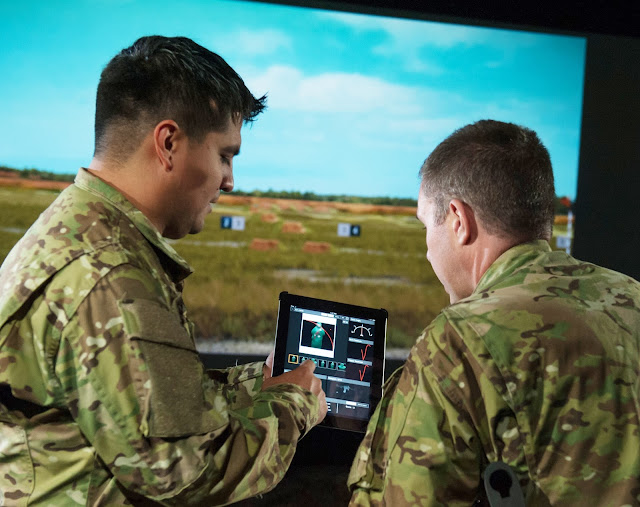 |
| FATS M100 (Photo: Meggitt Training Systems) |
Speaking to MT, Perez explained: “
We depend on our customers and internal subject matter experts [SMEs] to provide feedback on our systems and weapons. With our large base of customers, we have found that although the training outcome may be the same, every one of our customers teaches it differently. It is those things that give us such an advantage in creating better features compared to our previous generations of systems. Meggitt’s SMEs work so closely with the customer that they become an in-house voice for them on future projects.”
Meggitt has found that the customer procurement of a variety of different weapon systems has subsequently led to a wide diversity in requirement for simulators as armed forces seek more cost-efficient means of training. “
Meggitt Training Systems recognises that its customers have different training needs, so we assign dedicated teams. Many of the requirements set forth by our customers relate to weapons system fidelity or the precise commands that occur at their live ranges. Meggitt has to adhere to those standards, so that once the trainees hold those live weapons or go to that range it should be like muscle memory even if they have never been there before,” Perez stated.
Referring to the Italian MoD’s selection of
Beretta ARX 160 and GLX 160 weapon systems as its primary assault rifles, Perez explained how Meggitt had concurrently provided them with BlueFire wireless weapon simulators as well as upgrading existing small arms training systems such Meggitt’s very own FATS M100 trainer.
The FATS M100 now incorporates an open architecture allowing Armed Forces to integrate third-party training modules into their training programmes. It also includes technology upgrades in fidelity and graphic complexity for greater realism, as well as enhanced 3-D marksmanship, intelligent coaching applications using wireless tablets and VBS3-based collective training.
The BlueFire simulator provides VR technology while operators retain the capability of personal weapon systems instead of using substitute systems, optimised for simulation.
“
This allows for collective and judgmental training, operating via wireless Bluetooth technology, allowing it to communication with the FATS M100 system without cords or tethered operations hindering actions,” Perez continued.
Referring to current requirements from a variety of Armed Forces, he described how selection of a simulation system really came down to the fidelity of the weapons system, with customers demanding a simulator that will have the true tactile controls, weight and characteristics of its live counterpart.
The company is also responding to an RfI from the US DoD for a Virtual Portable M7 Military System providing up to eight soldiers to train in individual marksmanship lanes.
According to the solicitation, which was released in September, the system must be capable of providing “Escalation of Force” training, allowing soldiers to use less than lethal techniques to calm down a scenario before reverting to lethal weapon systems as a last resort.
The system must also have the ability to be integrated with the US Army’s and USAF’s Virtual Small Arms Military Trainer systems.
High Fidelity
Elsewhere,
Rockwell Collins has launched its latest offering in the realm of military simulation and training with the high fidelity EP-8100 Image Generator, designed to bring, “
new levels of realism and performance,” a company spokesperson informed MT.
According to
LeAnn Ridgeway, VP and GM for Simulation and Training at the company, the EP-8100 includes conversion software allowing existing Rockwell Collins synthetic environments to run in original form or enhanced context.
Other improvements include WholeEarth environment software, allowing large-area training with small inset development; advanced smoke, dust and heat haze conditions; high fidelity snow and rain effects; regional weather, allowing up to eight weather patterns to run concurrently across a single training area; adaptive architecture for more realistic clouds, dust and smoke; increased catalogues with high-resolution airport models available; and high fidelity sensor simulation encompassing IR, night vision, EO and laser light module requirements. The EP-8100 was unveiled to the international market at ITEC 2015.
Training with Consequences
With a background in supplying Armed Forces with laser-based simulation systems such as the Deployed Tactical Engagement System (DTES),
Saab has identified future trends beyond just simulated live firing of weapon systems.
 |
| Live fire simulation is no longer limited to small arms with Saab now having introduced a simulated variant of the CARL GUSTAF anti-tank guided munition. (photo: US DoD) |
According to the company’s
Head of UK Market Area Europe, Middle East and Africa, Claes-Peter Cederlof, concepts such as DTES could be enhanced with the additional integration of biometric data and combination of live and virtual training.
Describing how biometric data could not only be fed back to a tactical operations centre for exploitation purposes but also used to direct exercising troops in regards to medical assessment, first aid and casualty evacuation drills. “
Our latest Personal Detection Devices [PDDs] include a ‘Life Clock’ which reduces if a soldier is injured,” Cederlof explained to MT. “
A soldier can stop the clock reducing by inputting simulated medical treatment given to a casualty.”
According to Cederlof, the next few years will see an overhaul in the way Armed Forces train in light of troop cutbacks and financial constraints. He claimed the British Armed Forces, for example, spent approximately £5 million a year on ammunition, with most used for training scenarios. “
The UK could spend less if it understood the training environment better. Quantifiable training is more efficient, allowing exercising troops to measure hits and misses,” Cederlof explained while describing how many NATO nations up until now have been conducting relatively ineffective simulation training regimes.
This argument centres around the use of Location of Hit and Miss (LOHM) target boxes which measure incoming rounds landing within a 5m “suppression” box surrounding a pop-up target. Training for operations during the Cold War appear to have been prolonged ever since on condition that it is acceptable for exercising troops to miss the actual target but successfully “pin down” or suppress a target with rounds falling within the suppression box. Additionally, exercising troops would not receive any simulated incoming fire.
Recent COIN operations in Iraq, Afghanistan and elsewhere have resulted in the rethinking of such training regimes, with combat units now required to more precisely and accurately engage enemy targets located within densely populated urban areas.
Cederlof described new simulation regimes such as, “
training with consequences,” which allowed exercising troops to react to more effective incoming fire, whether from laser generated devices or marker cartridges. This type of training proves more effective with soldiers relying more upon use of cover for protection from incoming enemy fire as well as increased emphasis on movement with covering fire.
“
SOF have been doing this and it is time for the wider Armed Forces to start doing the same,” Cederlof added. “
Some conventional units are running the same exercises as they did 25 years ago.”
Anti Tank Options
It is not just small arms systems which are witnessing a revamp in simulation capabilities. Additionally, companies such as Saab are now offering simulated ground weapon systems such as those it provides for its CARL GUSTAF anti-tank guided munition (ATGM).
Highlighting how live ammunition remained very expensive, Cederlof explained how the Swedish Army continued to save millions of pounds by training with CARL GUSTAF ATGM laser simulators.
Current trends encompassing a mix of live fire, marker cartridges, subsonic and lower energy rounds look certain to maintain their place within the training regime of armed forces. Similarly, integration with laser-based technology such as Saab’s DTES will certainly appeal to militaries looking to execute the “Training with Consequences” mindset as described by Cederlof.
However, it will be interesting to monitor progress with the introduction of augmented reality technology, currently being promoted by companies including Applied Research Associates. Such a concept is currently being developed for SOF and dismounted soldiers but application in training regimes could revolutionise small combat unit training in the future.
Andrew White is a regular contributor to MT.





